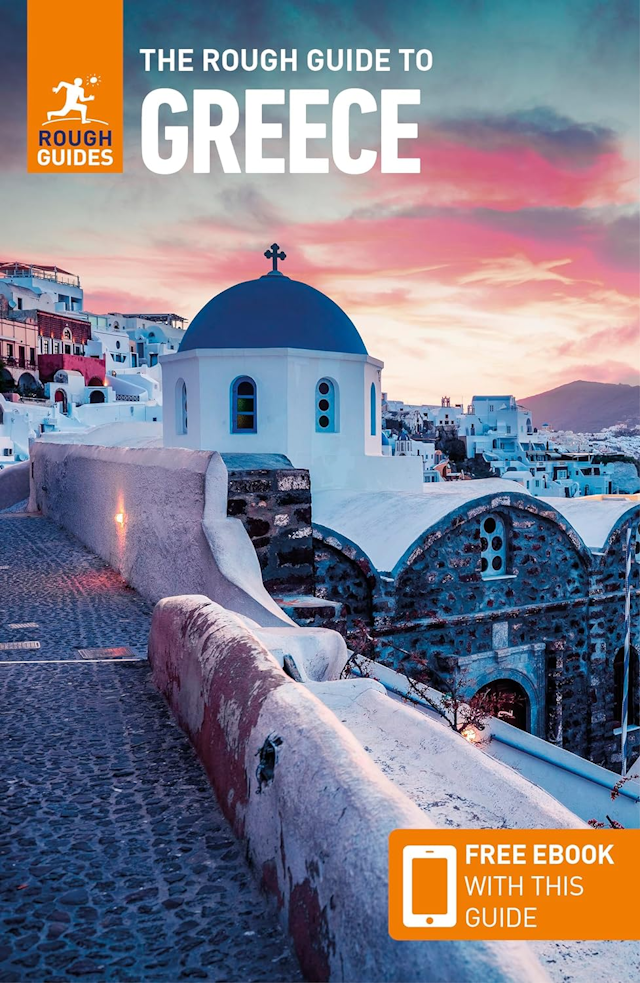- HOME
- Peloponnese
- Corinth
Corinth
Corinth has four aspects to it, which are the Corinth Canal, the modern town of Corinth, nearby Ancient Corinth, and above that Akrokorinthos or Upper Corinth.

Corinth Canal
The Corinth (Korinthos) Canal is one of the great sights of Greece. With luck, you might be there when a ship is being steered between the narrow, sheer walls which stretch away in the distance to link the Gulf of Corinth with the Aegean Sea. The only way to see it - apart from taking a boat through it - is to take the main road from Athens onto the Peloponnese, which crosses over the canal.
From the modern highway you need to exit and get onto the old road that runs parallel to it, and from there you can park and get out to have a lovely view down the canal, an engineering marvel which effectively turned the Peloponnese into a giant island.

Roman Emperor Nero (37-68 AD) first mooted the idea of cutting a canal through the isthmus so that ships could sail from Italy into the Aegean without going all the way round the Peloponnese. He performed the first symbolic excavation in person, using a silver shovel, but the task was never completed. Ships continued to sail up the Gulf of Corinth, unload their cargoes, and have them carried the 3.5 miles (6 km) to a ship waiting on the far side rather than risk losing the cargo on the sometimes stormy circuit around the Peloponnese.
It wasn't until 1893, after a total of 12 years work, that the 75-foot (23-metre) Corinth Canal was finally cut through, enabling boats to sail directly to Piraeus. The canal is still used, though less so these days as it isn't large enough to take the latest super-tankers.
Modern Corinth
A few miles beyond the canal is the modern town of Corinth, which delays few visitors except maybe as a refueling stop or to see its very good Folklore Museum. It's mainly an agricultural service town, but it's interesting to know that it's the centre of the Greek currant industry: the word 'currant' actually derives from the name Corinth.
There are hotels and restaurants if you need to spend the night, but the charms of Nafplion are little more than an hour's drive away, so head there for the evening.
Ancient Corinth
Beyond the modern town, the site of Ancient Corinth is to the south of the main road. Regular buses from modern Corinth also take visitors to and from the site. The site really comes to life as you walk around the well-preserved remains which are dominated by a Temple of Apollo from the 5th century BC. With its massive Doric columns, this is one of the buildings that the Romans left when they redeveloped the city as their provincial capital in 44BC. A small village has grown up around the site, and there are one or two places to stay and to eat.
The city was once home to 300,000 citizens and 460,000 more who were slaves - a total population bigger than today's Denver, Boston, or Washington DC. The smallest buildings are the ones that speak of the history: the remnants of shops, houses, and administrative buildings. The Peirine Fountain was a gift from Herodes Atticus, the wealthy Athenian, patron and friend of the Romans, and the spring beneath it still provides the water supply for the modern town of Corinth.
The Archaeological Museum on the site has a good display of remains found there. Some lovely mosaics, mostly dating from the second-century AD Roman period, are a good indication of the city's wealth at that time. Domestic vases, pottery, and jewellery all give the collection a more human scale.
Upper Corinth
Overlooking the lower city from the hilltop 2.5 miles (4 km) away was Akrokorinthos, or Upper Corinth. To get here you'll need a car or take a taxi from Corinth, and though it's a bit steep you can hike it or bike it too. Akrokorinthos's walls and spectacular views are the chief reasons to visit.
When you see the position the city commands, you realise its strategic importance and why it was refortified by every subsequent wave of invaders, including the Venetians, the Franks, and the Turks. The walls run for 1.25 miles (2 km) around the 60-acre (24-hectare) site, where you can find the remains of chapels, mosques, houses, fortifications, and the still-working Turkish Fountain of Hatzi Mustafa.
Latest Posts
-
Study: Athens Among Best Cities for Family Science Trips
Athens is ranked as one of the top European cities for family science trips, according to a report by Ubuy, a global e-commerce platform. Ubuy’s new report reveals Europe’s top 20 cities where familie… -
May 1: Greece Labor Day Strikes to Halt Public Transport, Ferries
Transportation and travel in Greece will be disrupted on Wednesday, May 1, as public transport and ferry employees have announced their participation in strike mobilizations to mark May Day. According… -
Technopolis: New 3-day Beer Festival Coming to Athens in May
A new beer festival is coming to Athens and for three days will quench the thirst of beer lovers with well-known and rare labels from around the world as well as from Greek microbreweries. Lager? Pils… -
5 Reasons to Spend Easter in Meteora
Renowned for its spectacular “hanging” monasteries and reverent atmosphere, Meteora is the perfect place to spend Greek Easter. -
3 Must-Visit Islands for Greek Easter
Boasting spectacular landscapes and unique local traditions, the islands of Lesvos, Ikaria and Andros are ideal vacation destinations for Greek Easter. -
Easter Cookies from Smyrna, a 100-Year-Old Recipe
Discover the secret to making the most delicious Easter koulourakia (cookies) from Smyrna, passed down through five generations. -
Greece Launches Contactless ‘Tap & Pay’ System on Athens Airport Express Buses
The Greek Transport Ministry on Wednesday launched a pilot ‘Tap & Pay’ contactless payment system for passengers traveling on the express bus lines in Athens that connect to Athens International Airpo… -
Acropolis Museum Exhibition: The Parthenon and Byron
On the occasion of 200 years since Lord Byron’s death, the Acropolis Museum in Athens is honoring his memory with a symbolic exhibition related to Lord Elgin’s taking of the Parthenon sculptures. -
Greece Bans Sunbeds, Umbrellas, Bars on 198 Beaches
Sunbeds, umbrellas, and all sorts of constructions have been banned on 198 beaches across Greece according to a joint ministerial decision signed this week by Economy & Finance Minister Kostis Hatzida… -
4 Guesthouses in Zagori that Are Worth Visiting
Amidst the mountains and spectacular scenery, these four traditional guesthouses in the heart of Zagori, Epirus, offer the very best in Greek hospitality.



























